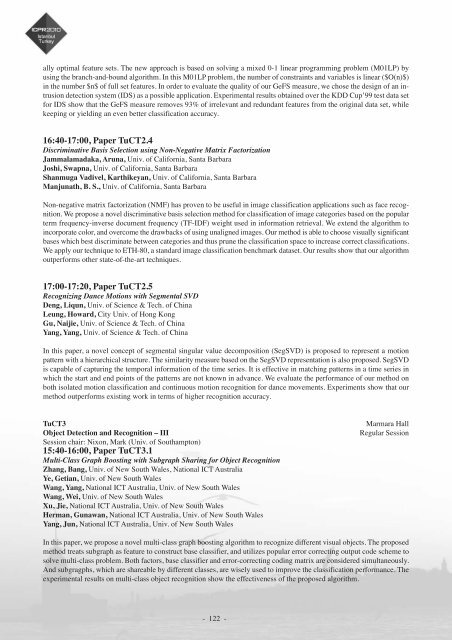Abstract book (pdf) - ICPR 2010
Abstract book (pdf) - ICPR 2010
Abstract book (pdf) - ICPR 2010
- TAGS
- abstract
- icpr
- icpr2010.org
You also want an ePaper? Increase the reach of your titles
YUMPU automatically turns print PDFs into web optimized ePapers that Google loves.
ally optimal feature sets. The new approach is based on solving a mixed 0-1 linear programming problem (M01LP) by<br />
using the branch-and-bound algorithm. In this M01LP problem, the number of constraints and variables is linear ($O(n)$)<br />
in the number $n$ of full set features. In order to evaluate the quality of our GeFS measure, we chose the design of an intrusion<br />
detection system (IDS) as a possible application. Experimental results obtained over the KDD Cup’99 test data set<br />
for IDS show that the GeFS measure removes 93% of irrelevant and redundant features from the original data set, while<br />
keeping or yielding an even better classification accuracy.<br />
16:40-17:00, Paper TuCT2.4<br />
Discriminative Basis Selection using Non-Negative Matrix Factorization<br />
Jammalamadaka, Aruna, Univ. of California, Santa Barbara<br />
Joshi, Swapna, Univ. of California, Santa Barbara<br />
Shanmuga Vadivel, Karthikeyan, Univ. of California, Santa Barbara<br />
Manjunath, B. S., Univ. of California, Santa Barbara<br />
Non-negative matrix factorization (NMF) has proven to be useful in image classification applications such as face recognition.<br />
We propose a novel discriminative basis selection method for classification of image categories based on the popular<br />
term frequency-inverse document frequency (TF-IDF) weight used in information retrieval. We extend the algorithm to<br />
incorporate color, and overcome the drawbacks of using unaligned images. Our method is able to choose visually significant<br />
bases which best discriminate between categories and thus prune the classification space to increase correct classifications.<br />
We apply our technique to ETH-80, a standard image classification benchmark dataset. Our results show that our algorithm<br />
outperforms other state-of-the-art techniques.<br />
17:00-17:20, Paper TuCT2.5<br />
Recognizing Dance Motions with Segmental SVD<br />
Deng, Liqun, Univ. of Science & Tech. of China<br />
Leung, Howard, City Univ. of Hong Kong<br />
Gu, Naijie, Univ. of Science & Tech. of China<br />
Yang, Yang, Univ. of Science & Tech. of China<br />
In this paper, a novel concept of segmental singular value decomposition (SegSVD) is proposed to represent a motion<br />
pattern with a hierarchical structure. The similarity measure based on the SegSVD representation is also proposed. SegSVD<br />
is capable of capturing the temporal information of the time series. It is effective in matching patterns in a time series in<br />
which the start and end points of the patterns are not known in advance. We evaluate the performance of our method on<br />
both isolated motion classification and continuous motion recognition for dance movements. Experiments show that our<br />
method outperforms existing work in terms of higher recognition accuracy.<br />
TuCT3 Marmara Hall<br />
Object Detection and Recognition – III Regular Session<br />
Session chair: Nixon, Mark (Univ. of Southampton)<br />
15:40-16:00, Paper TuCT3.1<br />
Multi-Class Graph Boosting with Subgraph Sharing for Object Recognition<br />
Zhang, Bang, Univ. of New South Wales, National ICT Australia<br />
Ye, Getian, Univ. of New South Wales<br />
Wang, Yang, National ICT Australia, Univ. of New South Wales<br />
Wang, Wei, Univ. of New South Wales<br />
Xu, Jie, National ICT Australia, Univ. of New South Wales<br />
Herman, Gunawan, National ICT Australia, Univ. of New South Wales<br />
Yang, Jun, National ICT Australia, Univ. of New South Wales<br />
In this paper, we propose a novel multi-class graph boosting algorithm to recognize different visual objects. The proposed<br />
method treats subgraph as feature to construct base classifier, and utilizes popular error correcting output code scheme to<br />
solve multi-class problem. Both factors, base classifier and error-correcting coding matrix are considered simultaneously.<br />
And subgragphs, which are shareable by different classes, are wisely used to improve the classification performance. The<br />
experimental results on multi-class object recognition show the effectiveness of the proposed algorithm.<br />
- 122 -



